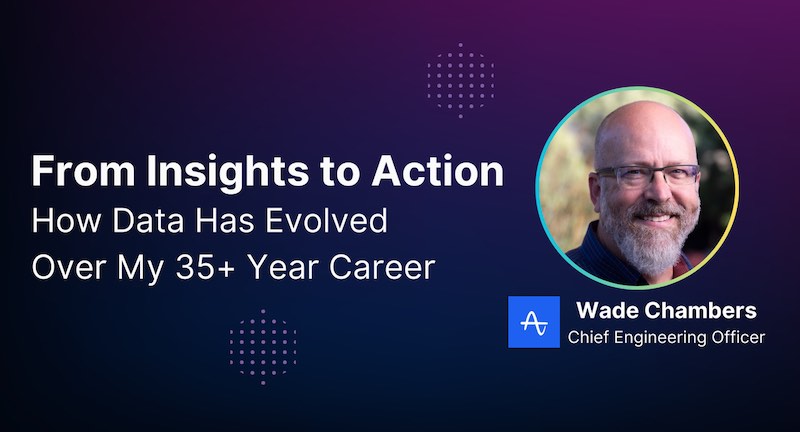Use Cases
Docs
Blog Articles
BlogResources
Pricing
PricingFrom Insights to Action: How Data Has Evolved Over My 35+ Year Career

Chief Engineering Officer, Amplitude Inc.
Table of Contents
- Introduction
- From Insights to Action: How Data Has Evolved Over My 35+ Year Career
- New Tools to Bridge the Gap: A Modern Data Flow for Better Insights and Actions
- Intelligent Data Integration and Orchestration: Streamlining Data Collection
- Unified Real-Time Data Platforms: Processing Data as It Happens
- Advanced Analytics and User Behavior Platforms: Analyzing and Understanding the Data
- AI-Driven Insights Generation and Decision Support: Automating the Analysis
- The Promise of Data: Speed, Simplicity, and Human-Centric Insights
- Conclusion
Introduction
The majority of the technical leaders that I talk with are deeply aware and involved in the growing pains of navigating the vast, ever-evolving data landscape. With data now at the heart of every strategic decision, the pressure is on to turn raw information into actionable insights that drive results … and do it quickly. But as data systems grow more complex and the volume of information balloons, moving from collection to real-time analysis and action has become increasingly challenging.
In my 35+ years in technology, I’ve witnessed this evolution firsthand: from direct user interactions and rapid iteration to today’s intricate web of analytics, real-time processing, and AI-driven insights. The data dilemma is clear: how do we design systems that not only handle the growing complexity but also empower our teams to make decisions at the speed of business insight?
This blog dives into the latest generation of tools that are redefining the data-to-action pipeline. We’ll explore how unified real-time data platforms, advanced analytics, and AI can help you streamline data architectures, reduce costs, and enable faster, more informed decisions. If you’re looking to simplify your data strategy and accelerate your product’s impact, read on.
From Insights to Action: How Data Has Evolved Over My 35+ Year Career
Throughout my career, data has been at the core of creating value. In the early days, we gathered information from users to improve product personalization. But over the last 25 years, we’ve evolved: organizing, enriching, and leveraging data to deliver exceptional user experiences.
While our understanding of data has grown, so have the complexities. Systems have become more intricate, data volumes larger, and the number of people involved in the process has multiplied. These factors create both opportunities and challenges, particularly around how we extract, understand, and act on insights effectively.
The Early Days: Rapid Iteration with Direct User Engagement
In the early days, it was common for engineers, designers, and product managers to work directly with users and clients. We observed their needs firsthand, made changes quickly, and received feedback almost immediately. It wasn’t sophisticated analytics that drove progress back then – it was simple, human-centric insights.
I recall working with clients and users “on site” so we could prototype and refine experiences in a matter of hours to days. This direct engagement allowed us to build products that genuinely met user needs, with immediate feedback loops and quick iterations.
The Rise of Data Professionals: Unlocking New Possibilities
About 15 years ago, things changed meaningfully for me with the emergence of data professionals – data scientists, analysts, and engineers. This shift turned data from a byproduct of user activity into a strategic asset for personalization, prediction, and optimization.
Companies like Amazon began building recommendation engines based on user behavior, creating personalized shopping experiences. Netflix used data not only to recommend content but also to guide their production of original series. However, the value of these insights depended heavily on the human element—interpreting complex data and translating it into actionable steps.
The success of Spotify’s “Discover Weekly” playlists also came from analyzing millions of listening habits. This required not just the right data but the right understanding of what those data points meant for individual users, transforming raw insights into uniquely tailored experiences.
The Modern Data Dilemma: Moving at the Speed of Data
Today, our ability to gather and process data has increased exponentially. However, the challenge remains: understanding and acting on this data quickly. We now deal with massive datasets scattered across various systems—CRMs, ERPs, Logs, analytics platforms—which can be time-consuming to integrate. Even when unified, the sheer volume and complexity can overwhelm decision-makers.
Adding to this, generative AI introduces both complexity and opportunity. Tools like OpenAI’s GPT can synthesize new content and generate insights from vast datasets, creating a wealth of information. But this also means more data to interpret, and if not carefully managed, it can amplify noise instead of clarifying what actions to take.
Traditionally, data teams extract, clean, and move data into warehouses before analysis. Even then, making sense of the data requires multiple layers of human involvement. What was once a straightforward feedback loop has turned into a lengthy process involving complex systems and multiple teams.
New Tools to Bridge the Gap: A Modern Data Flow for Better Insights and Actions
As data complexities grow, a new wave of tools is reshaping how businesses harness and act on insights. The data journey today involves several steps, each addressed by specialized tools that work together to enable real-time, data-driven decision-making. Here’s how this data flow typically progresses, highlighting the key benefits and companies leading in each category.
Intelligent Data Integration and Orchestration: Streamlining Data Collection
The first step in the data journey is collecting, unifying, and preparing data from various sources. This process can be labor-intensive, requiring the gathering of data from websites, apps, databases, and other systems. Intelligent data integration platforms solve this problem by centralizing data collection, ensuring data is clean and ready for further analysis.
Companies like Segment (now part of Twilio) play a critical role in this phase. Acting as a central hub, it collects customer data from different touchpoints—websites, mobile apps, and CRM systems—and routes it to analytics and processing tools. For example, an e-commerce company can use Segment to capture user interactions across its website and app, ensuring that standardized data flows seamlessly into other platforms. This streamlining of data integration allows teams to focus on analyzing user behavior rather than spending time on manual data wrangling.
Unified Real-Time Data Platforms: Processing Data as It Happens
Once the data is collected, the next step is processing it in real time. Traditional data processing systems, such as Kafka and Flink, can be complex and costly to maintain but helped show what was possible: an integrated solution to handle data in motion, reducing latency and enabling quicker responses.
Companies like InfinyOn improve in this space by providing an all-in-one real-time data streaming platform. By replacing traditional, complex setups, InfinyOn simplifies data modeling, understanding, and processing while enhancing developer productivity and reducing costs. Imagine a retail company using InfinyOn to monitor customer behavior on their website in real time. The platform can process this data as it’s generated, allowing the company to adjust product recommendations or pricing strategies instantly. This architecture enables businesses to respond to user interactions promptly, driving customer satisfaction and operational efficiency.
Advanced Analytics and User Behavior Platforms: Analyzing and Understanding the Data
After data is processed, the next step is extracting actionable insights. Advanced analytics platforms focus on helping teams explore user interactions, identify trends, and understand factors that drive engagement, retention, and conversion.
Companies like Amplitude are key in this category, offering product teams intuitive tools for deep analysis of user journeys, funnels, and cohorts. For instance, a media streaming service can use Amplitude to track which content types keep users engaged the longest or pinpoint where they drop off in their journey. With its user-friendly interface, product managers can quickly turn these insights into action, such as refining content strategies or prioritizing new features. By providing real-time analytics, Amplitude reduces guesswork, enabling teams to make informed decisions that enhance user experiences.
AI-Driven Insights Generation and Decision Support: Automating the Analysis
The final step in the data flow is turning insights into action. This is where AI-driven insights generation tools come in, leveraging generative AI to analyze complex datasets, generate narratives, and even provide decision support. These tools make it easier for teams to act on the insights quickly.
Consider a subscription service provider looking to understand customer churn. Instead of manually sifting through data, they can use AI tools like OpenAI’s GPT to identify patterns in customer behavior and generate reports that highlight key factors contributing to churn. The AI might even suggest potential interventions, such as targeted promotions for at-risk customers. This automation accelerates decision-making and democratizes insights, giving various teams the power to make data-driven recommendations.
The Promise of Data: Speed, Simplicity, and Human-Centric Insights
The emergence of these tools, along with advancements in generative AI, signals a promising shift in how we handle data. By making insights more accessible and reducing the time from data collection to action, we’re better equipped to meet user expectations in real-time.
Looking ahead, the next wave of products and services will focus on simplifying data interpretation and enabling teams to act at the speed users demand. I believe companies like InfinyOn will play a central role in building cost-optimized, agile data ecosystems while companies like Amplitude will continue to drive advanced user behavior analytics, while generative AI tools will provide automated insights and decision support. Together, these tools, complemented by Segment for seamless data integration, will form a robust ecosystem that bridges the gap between data and action.
Conclusion
The evolution of data practices has been remarkable, transforming industries from e-commerce to entertainment. Companies like Amazon, Netflix, Spotify, and Airbnb have shown how data can create tremendous value. However, the progress we seek is not just about technological advancement; it’s about enhancing our ability to interpret and act on data effectively.
To truly harness data’s potential, we need tools that go beyond costly collection and processing. We need cost effective solutions that make insights understandable and actionable, empowering decision-makers at every level. With companies like InfinyOn, Amplitude, Segment, and advancements in generative AI, the future is promising. These tools strike a balance between technology and human-centric design, helping us finally operate at the speed of our users and transform insights into action more seamlessly than ever before.
Next Steps
As businesses continue to navigate the complex landscape of data-driven decision making, it’s crucial to have the right tools and expertise at your disposal. If you’re looking to streamline your data processes, gain deeper insights, and take action in real-time, you will need to pick the right data infrastructure.
To learn more about how InfinyOn can transform your data strategy and empower your team to make faster, more informed decisions, contact us for a demo today. Let’s unlock the full potential of your data together.
Stay in Touch:
- Join our community on Github Discussions or Discord to share your insights on stateful data flows.
- Subscribe to our YouTube channel for more tutorials and updates.
- Follow us on Twitter for the latest news.
- Connect with us on LinkedIn for professional networking.

